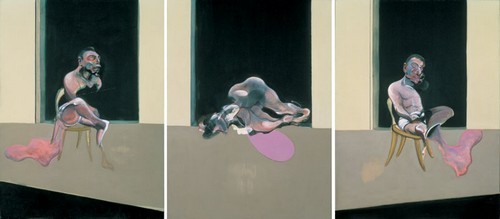Francis Bacon
11 Sep 2008 - 04 Jan 2009

Francis Bacon
Triptych – August, 1972
Oil on canvas
198 x 1475 mm each
© The Estate of Francis Bacon/DACS 2008 Tate
Triptych – August, 1972
Oil on canvas
198 x 1475 mm each
© The Estate of Francis Bacon/DACS 2008 Tate
Francis Bacon is internationally acknowledged as among the most powerful painters of the twentieth century. His vision of the world was unflinching and entirely individual, encompassing images of sensuality and brutality, both immediate and timeless. When he first emerged to public recognition, in the aftermath of the Second World War, his paintings were greeted with horror. Shock has since been joined by a wide appreciation of Bacon's ability to expose humanity's frailties and drives.
This major retrospective gathers many of his most remarkable paintings and is arranged broadly chronologically. Bacon's vision of the world has had a profound impact. It is born of a direct engagement that his paintings demand of each of us, so that, as he famously claimed, the 'paint comes across directly onto the nervous system'.
As an atheist, Bacon sought to express what it was to live in a world without God or afterlife. By setting sensual abandon and physical compulsion against hopelessness and irrationality, he showed the human as simply another animal. As a response to the challenge that photography posed for painting, he developed a unique realism which could convey more about the state of existence than photography's representation of the perceived world. In an era dominated by abstract art, he amassed and drew upon a vast array of visual imagery, including art of the past, photography and film. These artistic and philosophical concerns run like a spine through the present exhibition.
This major retrospective gathers many of his most remarkable paintings and is arranged broadly chronologically. Bacon's vision of the world has had a profound impact. It is born of a direct engagement that his paintings demand of each of us, so that, as he famously claimed, the 'paint comes across directly onto the nervous system'.
As an atheist, Bacon sought to express what it was to live in a world without God or afterlife. By setting sensual abandon and physical compulsion against hopelessness and irrationality, he showed the human as simply another animal. As a response to the challenge that photography posed for painting, he developed a unique realism which could convey more about the state of existence than photography's representation of the perceived world. In an era dominated by abstract art, he amassed and drew upon a vast array of visual imagery, including art of the past, photography and film. These artistic and philosophical concerns run like a spine through the present exhibition.
